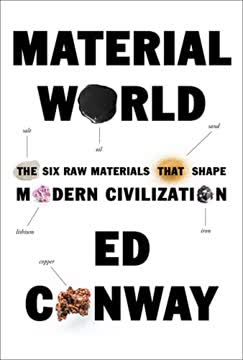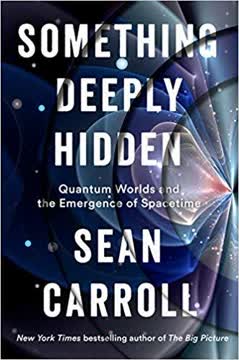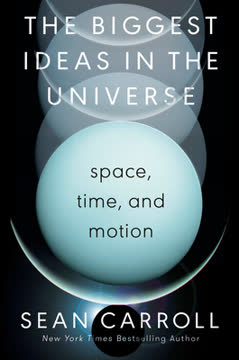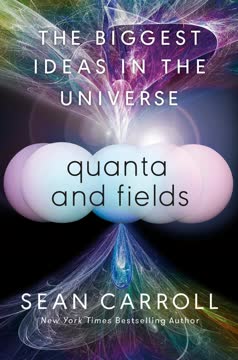Key Takeaways
1. The Higgs boson: Completing the Standard Model puzzle
The Higgs boson, in a very real sense, is what brings the universe to life.
The Higgs field permeates space. This field gives mass to elementary particles, allowing them to form atoms and molecules. Without it, particles like electrons would be massless and move at the speed of light, making the formation of matter as we know it impossible. The Higgs boson is a vibration in this field, discovered in 2012 at the Large Hadron Collider (LHC).
The Standard Model explained:
- 12 matter particles (fermions): 6 quarks and 6 leptons
- 4 force-carrying particles (bosons): photons, gluons, W and Z bosons
- The Higgs boson: gives mass to other particles
The Higgs boson's discovery completed the Standard Model, our best theory of particle physics. It explains the behavior of all known elementary particles and three of the four fundamental forces (excluding gravity).
2. Particle accelerators: Engineering marvels pushing scientific boundaries
The Large Hadron Collider is the largest, most complex machine ever built by human beings, and it came in at a cool nine billion dollars.
The LHC is a technological marvel. It's a 17-mile circular tunnel housing superconducting magnets that accelerate protons to nearly the speed of light. When these protons collide, they create conditions similar to those just after the Big Bang, allowing scientists to study fundamental particles and forces.
Key features of the LHC:
- Temperature: Colder than outer space (-456°F)
- Vacuum: As empty as interplanetary space
- Magnetic field: 100,000 times stronger than Earth's
- Data produced: 15 million gigabytes per year
The LHC represents the culmination of decades of accelerator development, from early cyclotrons to the Tevatron at Fermilab. These machines have consistently pushed the boundaries of energy and precision, enabling discoveries that shape our understanding of the universe.
3. Symmetry and forces: The fundamental principles shaping our universe
Symmetries lead to connection fields, and bends and twists in the connection fields lead to forces of nature.
Symmetry underlies nature's forces. In physics, symmetry refers to transformations that don't change the laws of physics. These symmetries give rise to conserved quantities (like energy) and fundamental forces. The electromagnetic, weak, and strong nuclear forces all arise from symmetries in quantum fields.
Types of symmetries in physics:
- Global symmetries: Same transformation everywhere
- Local (gauge) symmetries: Can vary at each point in space
- Spontaneously broken symmetries: Hidden in everyday conditions
The Higgs mechanism involves spontaneously breaking the symmetry of the weak force, giving mass to particles while preserving the underlying mathematical structure. This concept of symmetry breaking is crucial for understanding how the universe evolved from its symmetric early state to the complex structures we see today.
4. Dark matter: The invisible cosmic mystery
Count up the electric charge before and after the neutron decays. Beforehand it's zero, because you just have a chargeless neutron. Afterward it's also zero; the proton has a positive charge, but the electron has a precisely balancing negative charge, and the antineutrino has no charge at all.
Dark matter is invisible yet crucial. Astronomical observations show that there's much more matter in the universe than we can see. This invisible "dark matter" interacts gravitationally but doesn't emit or absorb light. It makes up about 85% of the matter in the universe.
Properties of dark matter:
- Electrically neutral
- Stable (or very long-lived)
- Weakly interacting with ordinary matter
- Distributed in halos around galaxies
The search for dark matter particles is ongoing, with experiments looking for direct detection (particles interacting with detectors on Earth), indirect detection (observing products of dark matter annihilation in space), and production at particle accelerators like the LHC. The Higgs boson might provide a "portal" to understanding dark matter, as many theories predict it could interact with both ordinary and dark matter particles.
5. The quest for unification: Supersymmetry and string theory
String theory isn't simply a theory of one-dimensional strings. There are also higher-dimensional objects that play a crucial role.
Beyond the Standard Model. While the Standard Model is incredibly successful, it doesn't explain everything. Physicists are searching for a more comprehensive theory that could unify all forces, including gravity, and explain phenomena like dark matter.
Promising ideas for unification:
- Supersymmetry: Proposes a partner particle for each known particle
- String theory: Suggests all particles are vibrations of tiny strings
- Extra dimensions: Hidden spatial dimensions beyond the familiar three
These theories are highly speculative and lack experimental evidence. However, they offer potential solutions to problems like the hierarchy problem (why gravity is so much weaker than other forces) and could provide a framework for quantum gravity. The LHC and future experiments will continue to search for signs of these theories.
6. From theory to discovery: The long journey of the Higgs boson
The answer is yes, there were hints that the LHC was actually seeing the Higgs. Just hints, mind you; not the final word.
Decades of theoretical work. The Higgs mechanism was proposed in the 1960s by several physicists, including Peter Higgs, François Englert, and Robert Brout. It took nearly 50 years of theoretical refinement and experimental advances before the particle was discovered.
Key milestones in the Higgs search:
- 1964: Higgs mechanism proposed
- 1967-1968: Incorporated into electroweak theory
- 1983: W and Z bosons discovered, validating aspects of the theory
- 1995-2000: LEP accelerator searches for Higgs (unsuccessful)
- 2012: Higgs boson discovered at the LHC
The discovery process involved analyzing vast amounts of data from millions of particle collisions. Statisticians played a crucial role in determining the significance of the observed "bump" in the data that signaled the Higgs boson's presence. The journey from theoretical prediction to experimental confirmation showcases the power of the scientific method and international collaboration in physics.
7. The value of fundamental research: Inspiring wonder and driving progress
It has only to do with the respect with which we regard one another, the dignity of man, our love of culture. It has to do with: Are we good painters, good sculptors, great poets? I mean all the things we really venerate in our country and are patriotic about. It has nothing to do directly with defending our country except to make it worth defending.
Basic research enriches humanity. While particle physics might not have immediate practical applications, it represents humanity's quest to understand the fundamental nature of reality. This pursuit of knowledge drives technological innovation, inspires future scientists, and contributes to our cultural heritage.
Impacts of particle physics research:
- Technological spinoffs: The World Wide Web, medical imaging techniques
- Cutting-edge engineering: Superconducting magnets, particle detectors
- Computational advances: Grid computing, big data analysis
- International collaboration: Model for large-scale scientific projects
- Public engagement: Sparking interest in science and critical thinking
Fundamental research like particle physics pushes the boundaries of human knowledge and capability. It challenges us to ask big questions about the nature of the universe and our place within it. While the practical benefits are often unpredictable, the process of discovery itself is valuable, fostering innovation, collaboration, and a sense of wonder about the world around us.
Last updated:
FAQ
What's The Particle at the End of the Universe about?
- Higgs boson exploration: The book delves into the search and discovery of the Higgs boson, a fundamental particle crucial to the Standard Model of particle physics.
- Human and scientific narrative: Sean Carroll intertwines personal stories of physicists with scientific exploration, highlighting the dedication and passion behind the research.
- Impact on physics: It emphasizes the pivotal role of the Higgs boson discovery in modern physics, potentially leading to new theories and understandings of the universe.
Why should I read The Particle at the End of the Universe?
- Accessible science writing: Sean Carroll presents complex concepts in an engaging and understandable manner, suitable for both lay readers and those with a scientific background.
- Insight into scientific discovery: The book offers a behind-the-scenes look at the Large Hadron Collider and the collaborative efforts of scientists worldwide.
- Philosophical and cultural significance: Carroll explores philosophical questions and emphasizes the importance of fundamental research in understanding the universe.
What are the key takeaways of The Particle at the End of the Universe?
- Higgs boson significance: The Higgs boson is essential for explaining why particles have mass, which is fundamental to the structure of matter.
- Role of the Higgs field: The Higgs field permeates the universe, giving mass to particles as they interact with it, crucial for the formation of atoms.
- Future of particle physics: The discovery opens doors to new physics beyond the Standard Model, as scientists continue to explore remaining mysteries.
What are the best quotes from The Particle at the End of the Universe and what do they mean?
- “People underestimate the impact of a new reality.”: Highlights the transformative nature of scientific discoveries, particularly the Higgs boson.
- “My hope for what the LHC will find is ‘none of the above.’”: Reflects the excitement of unexpected discoveries in scientific exploration.
- “Finding it is its own reward.”: Captures the intrinsic motivation of scientists in their quest for knowledge.
What is the Higgs boson and why is it important?
- Fundamental particle: The Higgs boson is associated with the Higgs field, which gives mass to other particles, confirming a key aspect of the Standard Model.
- Mass and structure of matter: Without it, particles would be massless, preventing the formation of atoms and molecules, essential for life.
- Gateway to new physics: Understanding the Higgs could unlock new theories about the universe, potentially leading to discoveries beyond the Standard Model.
How does the Higgs field give mass to particles?
- Interaction with particles: Particles gain mass by interacting with the Higgs field, with the strength of this interaction determining their mass.
- Spontaneous symmetry breaking: The Higgs field breaks the symmetry of particle interactions, allowing particles to have different masses.
- Field value in empty space: The Higgs field has a nonzero value in empty space, allowing particles to acquire mass.
What is the Standard Model of particle physics?
- Framework for understanding particles: Describes the fundamental particles and forces in the universe, excluding gravity.
- Success in predictions: Has been remarkably successful in predicting particle interactions, confirmed by numerous experiments.
- Limitations and future research: Does not account for dark matter, dark energy, or gravity, prompting ongoing research to extend or revise the model.
How was the Higgs boson discovered?
- Large Hadron Collider (LHC): The Higgs boson was discovered at the LHC, which collides protons at high energies to create conditions similar to the Big Bang.
- Data analysis: Experiments like ATLAS and CMS analyzed vast data from collisions, looking for decay patterns indicating the Higgs boson.
- Collaboration of scientists: Thousands of scientists worldwide collaborated, showcasing the importance of teamwork in modern research.
What role do Feynman diagrams play in particle physics?
- Visual representation: Feynman diagrams visualize and calculate interactions between particles in quantum field theory.
- Calculating probabilities: Each diagram corresponds to a mathematical expression for calculating interaction probabilities.
- Understanding complex processes: Simplify the analysis of complex interactions, aiding physicists in understanding fundamental particle behavior.
What are the implications of the Higgs boson for dark matter?
- Connection to WIMPs: The Higgs boson may interact with dark matter particles like WIMPs, providing a pathway for detection.
- Higgs portal concept: Suggests the Higgs boson could bridge the Standard Model and hidden matter sectors, leading to new discoveries.
- Future research directions: Understanding the Higgs may help uncover dark matter's nature, guiding future experiments and models.
How does the Higgs boson relate to supersymmetry?
- Supersymmetry theory: Posits every Standard Model particle has a heavier superpartner, with the Higgs boson providing insights into their existence.
- Hierarchy problem solution: Supersymmetry allows for cancellations in Higgs mass contributions, stabilizing it against high-energy physics.
- Search for superpartners: The Higgs discovery raises stakes for finding supersymmetric particles, potentially confirmed through interactions with the Higgs.
What challenges does particle physics face in the future?
- Funding and support: Experiments are costly, requiring effective communication of their value to secure funding and public support.
- Finding new physics: The Higgs discovery raises new questions, necessitating exploration beyond the Standard Model for new particles and forces.
- Technological advancements: Future experiments need innovative technologies to probe deeper into matter's fundamental nature, requiring adaptation and collaboration.
Review Summary
The Particle at the End of the Universe receives mostly positive reviews for its engaging explanation of the Higgs boson discovery and particle physics. Readers praise Carroll's ability to communicate complex concepts through analogies and humor. Many find it accessible for laypeople, though some struggle with more technical sections. The book is commended for its historical context and human stories behind the science. Some criticize oversimplification in parts, while others appreciate the balance of depth and readability. Overall, it's recommended for those interested in understanding the significance of the Higgs boson and modern particle physics.
Similar Books








Download PDF
Download EPUB
.epub digital book format is ideal for reading ebooks on phones, tablets, and e-readers.








